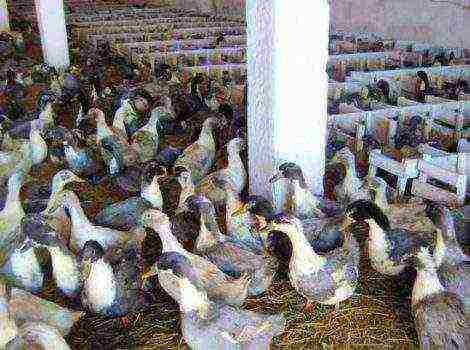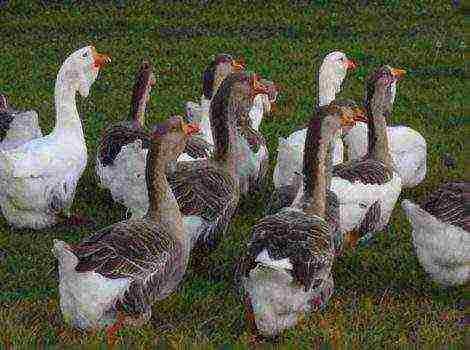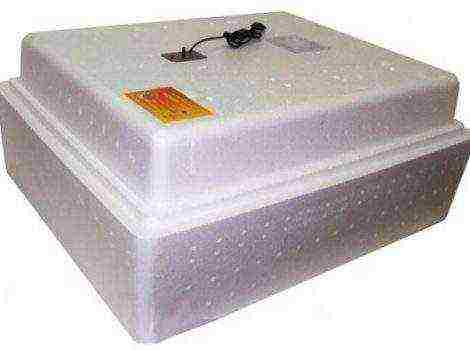Content
- 1 Incubating duck eggs at home
- 1.1 How to choose duck eggs for incubation at home
- 1.2 Factors that influence good hatching of ducklings
- 1.3 Egg setting and temperature
- 1.4 Differences between hatching and breeding in an incubator: how many chicks hatch
- 1.5 Incubation modes with periods
- 1.6 Table with the timing and humidity for incubating ducks
- 1.7 Which one to breed correctly: idol or musk ducks
- 1.8 Indoor incubation table and temperature regime
- 1.9 Mistakes when breeding ducklings in an incubator
- 1.10 Conclusion
Incubating duck eggs at home
The incubation of duck eggs at home is a very often used method of hatching poultry on farms and private households. This method is associated with the reluctance of adult ducks to hatch eggs, and it is also used when a large number of ducklings need to be reared.
In this article, we will look at the incubation of duck eggs at home, talk about the incubation period of duck eggs, find out how many days ducklings hatch in an incubator, and what modes are needed for this.
How to choose duck eggs for incubation at home
The eggs of different birds differ in appearance, which include:
- volume;
- shell appearance.
Duck eggs are larger, have a porous, thick greenish shell. Before the eggs enter the incubator, they must be carefully examined and selected according to the following principle:
- A duck egg must have weight from 75 to 95 grams;
- It should not be very elongated, round or non-standard;
- Eggs are chosen from thick, smooth and clean surface;
- The shell should not have no external defects, in the form of chips, deformations, cracks;
- You cannot store eggs for the incubator for more than seven days, therefore shelf life is best kept to a minimum.
Eggs that are prepared for breeding ducklings are strongly not recommended to be stored in the refrigerator. The best container in this case is special plywood trays, which are located in a cool place, where the air temperature should not be higher than +12 ° with good ventilation, while the humidity should be about 70%.
Eggs are laid on the tray with the blunt end down, and do not overlap them, this can affect the number of chicks hatched. Before they enter the incubator, they are periodically turned over.
Factors that influence good hatching of ducklings
To get the maximum number of poultry, you should pay attention to the following factors when breeding:
- carefully selected eggs;
- correct incubator;
- compliance with all incubation rules;
- ventilation;
- temperature in the incubator for duck eggs;
- compliance with temperature and humidity indicators.

Egg setting and temperature
Eggs before laying mute ducks should be carefully checked again, carefully remove all dirt. When bookmarking, the following rules should be observed:
- The incubator stands pre-install and warm up to the set temperature.
- A tray with water is placed in the lower part of the device, which should be very carefully monitored.
It is strongly not recommended to wash eggs before laying!
- The first step is to place larger specimens and, with an interval of four hours, medium and small ones.
- The position of the eggs should be horizontal, ducklings in this position hatch much better, however, they take up more space.
- The first seven days the temperature should be + 38 degrees, then it should be reduced to + 37.6.
- Humidity is measured using a special thermometer, which you can make yourself.To do this, take an ordinary thermometer and tie a cloth on its lower tip, the free tip that remains is dipped into a tray of water. He will show humidity.
- The first seven days humidity should be around 30 degrees, then its indicators are brought to 27 ° C.
It is very important to turn the eggs throughout the entire incubation process. It would be great if the incubator does this automatically. But if there is no such function, then you will have to turn the eggs yourself 6 times daily.
To improve metabolic processes and so that the chick develops more efficiently, a cooling process is used. Cooling should be soft and not prolonged... Most often, it is recommended to simply spray the eggs with water, the temperature of which should be about + 27 ° C. The procedure is carried out for about two minutes, then ten minutes are allowed to dry.
Differences between hatching and breeding in an incubator: how many chicks hatch
If there is an opportunity to incubate ducklings with the help of a hen, then it is better to use it, since this process has many positive aspects:
- ducks are very good hens;
- the bird conducts the process of irrigation with water much better and more correctly than a person;
- hatchability can be up to 100%, while an incubator gives approximately 70% of a positive result.
The incubation period in ducks lasts up to thirty days. It is worth remembering that when hatching is carried out with the help of a brood hen, the chicks may appear with a difference up to a day. Therefore, already hatched and completely dried ducklings are taken from their mother for a while, until all the babies hatch... This will guarantee that the duck will sit to the last.
Interesting breeds for breeding are:
- Bashkir ducks
- peking ducks
- musk ducks
The number of eggs that can be placed under the bird is much less than can be placed in an incubator. On average, a duck can hatch up to twenty eggs at a time, it all depends on the size of the bird. In an incubator, it all depends on the tray, as much is included in it, so much is correct.
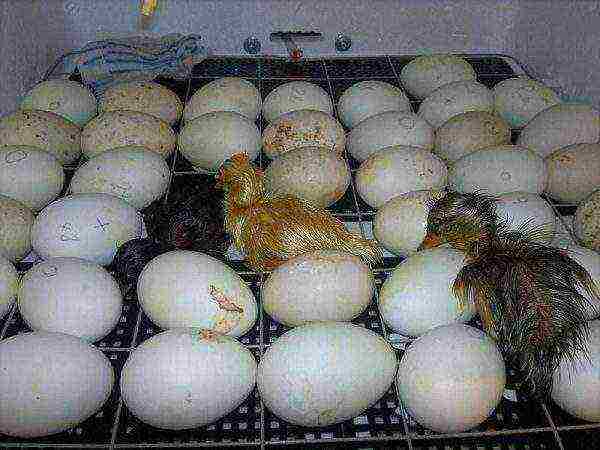
Incubation modes with periods
Indoor egg incubation mode is special conditions for breeding healthy offspring. This period is divided into several stages:
- In the initial period, it is very important that the water level and increased heat are maintained.
- In the middle of the hatch, the temperature and humidity are made lower, and the air flow is increased.
- Closer to the appearance of ducklings, it is worth lowering the temperature, but the humidity should be increased. Air access is maximized.
Temperature control is very important during all incubation periods. Refrigeration helps to make the development of the fetus much more efficient. It is also worth considering the following nuances, if at the beginning, a high temperature is acceptable, then in subsequent stages, it can be dangerous for the embryo.
Table with the timing and humidity for incubating ducks
|
Timing
|
Temperature |
Humidity |
Rollover |
Cooling |
Spraying |
|
1 – 12
|
+ 38 ° C |
70 % |
every 4 hours |
on the 6th day |
1 – 2 |
|
13 – 24
|
+ 37.4 ° C |
60 % |
every 4 hours |
2 times a day for 20 minutes |
2 |
|
25 – 28
|
+ 37 ° C |
85 % |
from day 26 stop |
from the 27th day it stops |
3 – 4 |
Which one to breed correctly: idol or musk ducks
Indo-ducks are a special breed of ducks that are distinguished by high quality meat. Also, this type of ducks is bred to obtain a delicious liver. Muscovy ducks are quite unpretentious and it is not necessary for them to take care of the presence of a reservoir.
After careful checking, eggs are loaded into the incubator horizontally. For the first two weeks, it is recommended to maintain a temperature of + 38 degrees, humidity should be at least 55% and no more than 65%. Egg turnover is done three times a day. On the 16th day, egg irrigation begins, with the help of water, which has a temperature of + 37 ° C. After that, the eggs are cooled for about half an hour.
Before loading eggs into the incubator, you can mark them on both sides in order to follow the overturn.
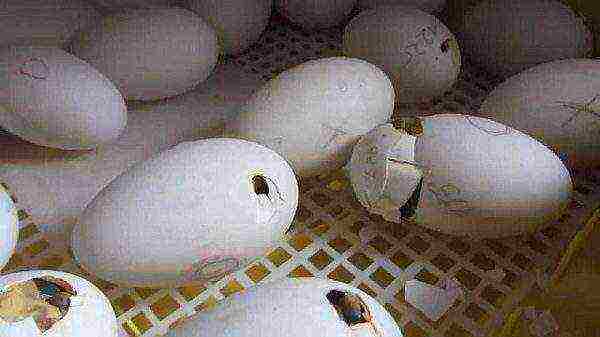
Indoor incubation table and temperature regime
Below we suggest that you familiarize yourself with the temperature regime table for incubating Indo-duck eggs.
|
Timing
|
Temperature |
Humidity
|
Coup |
Cooling |
Spraying |
|
1 – 16
|
+ 38 ° C |
70 % |
every 4 hours |
start from the 10th day |
1 |
|
17 – 29
|
+ 37.5 ° C |
60 % |
every 4 hours |
2 times a day for 20 minutes |
2 – 3 |
|
30 – 34
|
+ 37 ° C
|
85 % |
does not apply |
does not apply |
3 — 4 |
Mistakes when breeding ducklings in an incubator
Newbies in poultry breeding often make the following mistakes due to inexperience:
- Do not provide proper warm-up, which should be as uniform as possible. In order to avoid this error, it is worthwhile to use egg stirring before cooling. That is, from the edges of the eggs are transferred to the middle, and from the middle, respectively, spread along the edges.
- Overheat... Care must be taken to ensure that the embryos do not receive heatstroke, which can lead to death in the unborn chick.
After the chicks have hatched, they must be placed in a special container, which is equipped with ventilation. The temperature of the room where this box is located must be within + 24 ° C. A healthy chick should weigh about 70 grams.
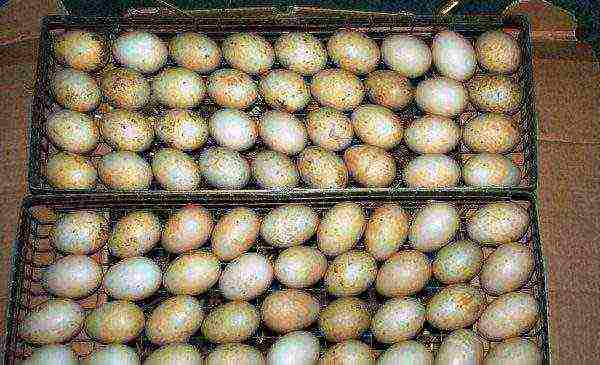
Conclusion
Experience is the best teacher, therefore, the more often a person takes out ducklings, the better and more effective he gets. And although poultry farming in our country is not yet developed. Over time, the situation will change markedly.
Of course, raising ducklings in an incubator at home is a painstaking business. But if all the steps are followed, it does not cause any difficulties. Over time, a novice poultry farmer will have his own secrets and he will learn to take into account even the slightest nuances. In the meantime, it is worth following all the tips and gaining experience.
